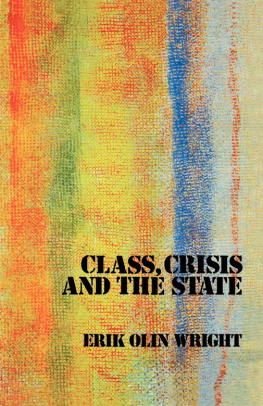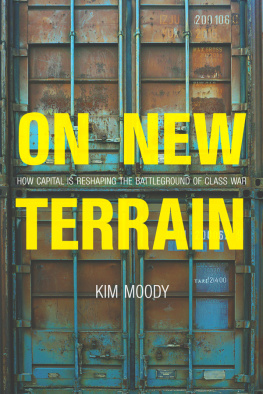
Table of Contents
List of Illustrations
- Chapter 06
- Chapter 24
Guide
Pages
CLASS THE ANTHOLOGY
Edited by Stanley Aronowitz and Michael J. Roberts
This edition first published 2018.
Editorial material and organization 2018 Stanley Aronowitz and Michael J. Roberts
All rights reserved. No part of this publication may be reproduced, stored in a retrieval system, or transmitted, in any form or by any means, electronic, mechanical, photocopying, recording or otherwise, except as permitted by law.Advice on how to obtain permision to reuse material from this title is available at http://www.wiley.com/go/permissions.
The right of Stanley Aronowitz and Michael J. Roberts to be identified as the authors of the editorial material in this work has been asserted in accordance with law.
Registered Offices
John Wiley & Sons, Inc., 111 River Street, Hoboken, NJ 07030, USA
John Wiley & Sons Ltd, The Atrium, Southern Gate, Chichester, West Sussex, PO19 8SQ, UK
Editorial Office
9600 Garsington Road, Oxford, OX4 2DQ, UK
For details of our global editorial offices, customer services, and more information about Wiley products visit us at www.wiley.com.
Wiley also publishes its books in a variety of electronic formats and by printondemand. Some content that appears in standard print versions of this book may not be available in other formats.
Limit of Liability/Disclaimer of Warranty
While the publisher and authors have used their best efforts in preparing this book, they make no representations or warranties with respect to the accuracy or completeness of the contents of this book and specifically disclaim any implied warranties of merchantability or fitness for a particular purpose. No warranty may be created or extended by sales representatives or written sales materials. The advice and strategies contained herein may not be suitable for your situation. You should consult with a professional where appropriate. Neither the publisher nor authors shall be liable for any loss of profit or any other commercial damages, including but not limited to special, incidental, consequential, or other damages.
Library of Congress CataloginginPublication data is available for this book.
ISBN 9780631224983 (hardback), 9780631224990 (paperback)
Cover Design: Wiley
Cover Image: Young Sam Green / EyeEm/Gettyimages
General Introduction
Stanley Aronowitz and Michael J. Roberts
This volume of documents, classic articles and original analysis by the editors remains controversial on several grounds. Despite the growing evidence that the global economy is dominated by a handful of leading corporations and the very rich individuals who control them, the conventional wisdom is that we live in a world of mom and pop enterprises. Accordingly, most citizens of the most industrially developed countries are termed middle class. For those who do not own their own businesses, we measure class by income and by consumption. Beneath this vast social group is the relatively small corps of the poor, a diminishing proportion of the population.
Mainstream political science insists that there is no ruling class or power elite in the functions of the state. Following the dictum, most forcefully established in the late 1950s by Yale political scientist Robert Dahl, whose book Who Governs? remains a bible for many, American politics consists of a plurality of organizations, including business, political parties, pressure groups on single issues, and unions, none of which, in advance, constitutes the leading edge of governance. This idea of American classlessness can be traced back to the immensely influential book Why There is No Socialism in the United States (1906) by the German economist and sociologist Werner Sombart. Sombart advanced the thesis that the workers were not a class in the European sense. They did not exhibit solidarity as a class because America is really the land of opportunity. It had no feudal tradition and possessed unlimited natural and economic resources. The urban political machines address and often solve the most pressing issues facing workers outside the workplace. Yet in subsequent years, especially the 1930s, 1940s and 1960s, American workers engaged in some of the sharpest strikes, factory occupations and demonstrations of any working class in advanced industrial capitalism, most of which were unauthorized by law. Even so, conventional social science remains adamant that class plays a subordinate or no role in the conduct of politics and the political economy. According to this view, the United States is a middle class society with a tiny stratum of the rich and a slightly larger underclass of the poor, who are declining over time. And the poor are poor because their families are dysfunctional or they lack the energy and the will to take advantage of prevailing opportunities to lift themselves out of poverty. Some anthropologists and sociologists advanced the theory that the poor wallow in a culture of poverty that effectively cuts them off from mainstream society. In the absence of outside intervention, either by the state or by private philanthropies this culture, it is held, is selfreproducing. Among the leading scholars of this position were Daniel Patrick Moynihan and Nathan Glazer, whose book Beyond the Melting Pot stirred fierce debate in the 1960s when the question of poverty commanded the nations attention and became a subject of national policy.
However, the most disputed idea that underlies this project is that we declare that our societies are constituted by three classes: a capitalist ruling class consisting of the tycoons of finance, the top political managers, the corporate elite, and in the United States what C. Wright Mills termed the warlords at the pinnacle of the military; a middle class of small business owners and salaried professionals and technical operatives who still enjoy some autonomy in the performance of their work; and the working class, employed or not, with decent or low income, who have little or no control over their labor. There they were employed in construction, factories and urban service industries, and some remained unemployed pending economic expansion. Second, under state control, the government invited foreign private capital to establish industrial plants and other enterprises. Third, the state began a program of expanded vocational and higher education to train skilled workers, scientific and technical personnel and managers. In contrast to the years following the conquest of power in 1949, the party and the government were eager to learn from the capitalist West, and to import its technologies. For example, scientists, engineers and students were sent abroad to acquire knowledge and training in their respective fields and western consultants were brought to China to train the indigenous population in management skills and technical fields.
By 2000 China was already a major global industrial power. It quickly overtook western countries in the production of textiles, shoes and clothing, but moved beyond light manufacturing to heavy machinery such as construction vehicles, electronics (computers, telephones and other equipment), petrochemicals and, within a few years, automobiles. Much of its industrial production was destined for export; its main internal market was among the growing middle class of small producers and professionals. The regime retained a substantial state sector, but the emphasis on attracting private capital marked a new phase in the countrys history. Chinas exports to the United States and Europe far exceeded its imports. By 2010, China was supplying inexpensive cars to the growing middle class of Southeast Asia and was beginning to penetrate the African and Latin American markets.
Next page






